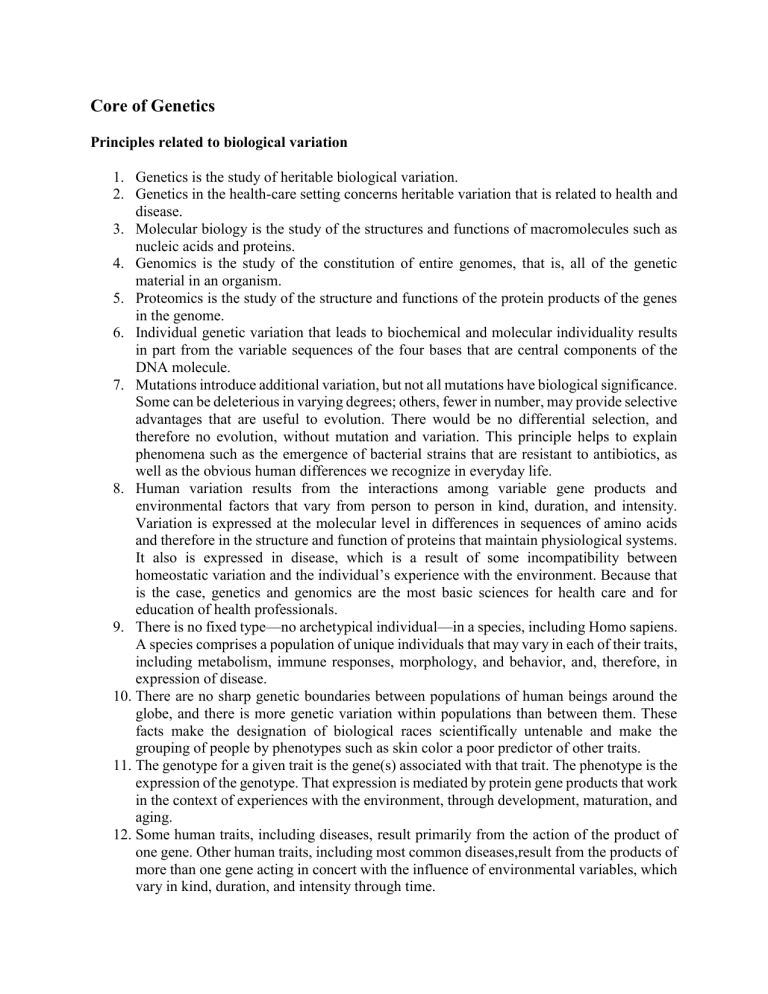
Core of Genetics Principles related to biological variation 1. Genetics is the study of heritable biological variation. 2. Genetics in the health-care setting concerns heritable variation that is related to health and disease. 3. Molecular biology is the study of the structures and functions of macromolecules such as nucleic acids and proteins. 4. Genomics is the study of the constitution of entire genomes, that is, all of the genetic material in an organism. 5. Proteomics is the study of the structure and functions of the protein products of the genes in the genome. 6. Individual genetic variation that leads to biochemical and molecular individuality results in part from the variable sequences of the four bases that are central components of the DNA molecule. 7. Mutations introduce additional variation, but not all mutations have biological significance. Some can be deleterious in varying degrees; others, fewer in number, may provide selective advantages that are useful to evolution. There would be no differential selection, and therefore no evolution, without mutation and variation. This principle helps to explain phenomena such as the emergence of bacterial strains that are resistant to antibiotics, as well as the obvious human differences we recognize in everyday life. 8. Human variation results from the interactions among variable gene products and environmental factors that vary from person to person in kind, duration, and intensity. Variation is expressed at the molecular level in differences in sequences of amino acids and therefore in the structure and function of proteins that maintain physiological systems. It also is expressed in disease, which is a result of some incompatibility between homeostatic variation and the individual’s experience with the environment. Because that is the case, genetics and genomics are the most basic sciences for health care and for education of health professionals. 9. There is no fixed type—no archetypical individual—in a species, including Homo sapiens. A species comprises a population of unique individuals that may vary in each of their traits, including metabolism, immune responses, morphology, and behavior, and, therefore, in expression of disease. 10. There are no sharp genetic boundaries between populations of human beings around the globe, and there is more genetic variation within populations than between them. These facts make the designation of biological races scientifically untenable and make the grouping of people by phenotypes such as skin color a poor predictor of other traits. 11. The genotype for a given trait is the gene(s) associated with that trait. The phenotype is the expression of the genotype. That expression is mediated by protein gene products that work in the context of experiences with the environment, through development, maturation, and aging. 12. Some human traits, including diseases, result primarily from the action of the product of one gene. Other human traits, including most common diseases,result from the products of more than one gene acting in concert with the influence of environmental variables, which vary in kind, duration, and intensity through time. 13. The development of disease reflects three time frames: a) the evolutionary history – biological and cultural – of our species, which has produced the genome common to all of us; b) the individual developmental history of each person, which interacts with the products of his or her genes, and c) the more immediate factors that results in the expression of disease at a particular moment. 14. The phrase “the gene for,” as in “the gene for phenylketonuria,” can be misleading. It can imply erroneously that only genetic influences are responsible for a given trait or disease, discounting the influence of the environment. The phrase also can suggest that only one gene is associated with a given trait when there may be genetic heterogeneity, of alleles and modifiers, as well as multiple loci. The blood-group substances and hemoglobin variants demonstrate such heterogeneity. 15. Genetically based health care, which now embraces genomics, is uniquely positioned to provide insights into prevention because it acknowledges the individuality of each patient and the biological and environmental influences that produce that individuality. Genetically based care focuses primarily on the person who has the disease, not on the disease itself. It asks, “Why does this person have this disease at this point in his or her life?” and it recognizes that individual variation in genes, development, and experiences means that each person has his or her own version of each disease. Principles related to cell biology 1. Classic cell theory holds that all life is made of cells and that all cells come from preexisting cells. 2. Cells pass through a series of structural and functional stages known as the cell cycle. The cell cycle, which includes processes leading to cell division, is under genetic control. Cancer results from one or more disruptions in that cell cycle. Because most of these disruptions occur in somatic cells (as opposed to germ cells) all cancer is genetic, but not all of it is inherited. 3. Cell division produces new cells. 4. Mitosis, one aspect of cell division, helps to ensure genetic continuity from one generation of somatic cells to the next. Human somatic cells contain 46 chromosomes (the diploid number): 22 pairs of autosomes and one pair of sex chromosomes (X and Y). 5. Human germ cells, sperm and ova, contain 23 chromosomes (the haploid number). A special process of cell division—meiosis—occurs in the precursors to germ cells. Meiosis has two major biological effects: it reduces the number of chromosomes from 46 to 23 and it increases genetic variation through independent assortment and through the exchange of genetic material between maternal and paternal chromosomes (crossing over). Meiotic variations can result in abnormalities of chromosome number or structure. 6. In Homo sapiens and in other animals, the fungi, and plants, cells contain a nucleus that includes the chromosomes, the carriers of most of the genetic material (DNA). 7. Human cells also contain mitochondria. Because mitochondria were free-living organisms early in the evolution of life, they carry their own DNA, which now specifies proteins that are useful to us. Mutations in mitochondrial DNA can cause health problems. Principles related to classical (Mendelian) genetics 1. Our understanding of the behavior of chromosomes during meiosis allows us to make predictions about genotype from one generation to the next. 2. Some traits are inherited through an autosomal dominant pattern of inheritance, others through an autosomal recessive pattern. Still others, those traits associated with genes on the X chromosome, follow somewhat different patterns of transmission because the male has only one X chromosome. 3. Traits, not genes, are dominant or recessive. It is convenient, even traditional, to refer to genes as dominant or recessive, but today it is anachronistic, because of our new knowledge of how protein gene products influence phenotype. 4. Aberrations in the behavior of chromosomes during meiosis can result in structural or numerical alterations that have serious consequences for growth and development. Some of these aberrations occur more frequently in the offspring of older mothers. Others arise more frequently during the formation of sperm. We can detect many chromosomal aberrations prenatally. They account for a significant proportion of fetal death, and to a lesser extent, death in infancy. 5. Our understanding of genes in populations allows us to make predictions about the presence of genes in individuals and in given populations and, therefore, about the variable frequencies of disease phenotypes. 6. During the last two decades, research has uncovered genetic mechanisms that extend our understanding of non-mendelian inheritance and that provide biological explanations for heretofore-unexplained observations. These mechanisms, such as imprinting, trinucleotide repeats, and epigenesis, however, do not alter our fundamental understanding of the rules that govern genetic and molecular processes. Principles related to molecular genetics 1. DNA and RNA are information molecules; they store biological information in digital form in a well-defined code. 2. DNA is the primary information molecule for virtually all life on earth; this is but one piece of evidence for the relatedness of all life through evolution. 3. DNA does very little by itself. It is a stable storehouse of genetic information, but it takes proteins to put the information to use. DNA’s transcription and the translation of its information into protein are accomplished by protein-mediated mechanisms. Similarly, the functions of the organs and body are carried out by sets of proteins whose properties and actions are not likely to be understood or predictable by our current knowledge of single genes or proteins. 4. The structure of DNA lends itself to replication. DNA replicates with great accuracy, which is critical to the proper transmission of genetic information from one generation of cells to the next and from one generation of organisms to the next. 5. Sometimes errors arise during DNA replication, and evolution has produced mechanisms that repair such mistakes. In fact, some of those mechanisms present in Homo sapiens are conserved evolutionarily all the way back to the bacterium E. coli. When repair mechanisms fail, mutations may remain. Some may become the basis for evolutionary change. 6. In most biological systems, the flow of information is: DNA → RNA → protein. The processes by which this occurs are replication of the DNA, transcription of the DNA into messenger RNA, and translation of the messenger RNA into protein. 7. DNA is susceptible to damage by environmental insults such as radiation and certain chemicals, and the damage that occurs to our DNA during the course of our lives can contribute to aging and the onset of cancer. Damage that occurs in the DNA of germ cells – sperm and ova – is not completely repaired. Evolution is a possible result of these new, heritable variations. 8. A gene is a segment of DNA. Some genes code for the production of structural proteins (collagen, for example) or enzymes (lactase, for example). Other genes are regulatory, helping to control such processes as prenatal development and ongoing cellular functions. 9. A gene occupies a particular place on a chromosome—a locus. A gene can have two or more alternative forms—alleles—but only one allele at a time can occupy a given locus on a given chromosome. 10. Because proteins direct the operations of cells, such statements as “gene-environment interaction” are inaccurate. The interaction is actually between the environment – for example, oxygen, food, drug, or antigen – and the protein products of the genes. Principles related to development 1. The human life span comprises three major phases: development, including embryological development and growth after birth until maturation; maturation; and aging. Progression through the stages is continuous, however, and apart from birth it is difficult to tell where one ends and the next begins. 2. Although virtually all human beings proceed through the same developmental stages, there are individual differences in the rate of progression. 3. Embryological development begins with the fusion of sperm and ovum. This event restores the diploid number and initiates a complex series of events that involves an increase in the number of cells; differentiation of the zygote into the specialized cells, tissues, and organs that make up a new, individual organism; and growth of the organism itself. 4. Embryological development is under genetic control. That is, particular genes must be turned on and off at the correct time to ensure proper development. 5. Development is not, however, the simple unfolding of a genetic program resulting in a predictable end product. It involves the influence of maternal mitochondrial genes and gene products at the time of fertilization, as well as significant and variable non-genetic factors such as communication between cells, the migration of cells within the developing embryo, the proper spatial orientation of the embryo, and the effects of environmental influences. These factors render the precise outcome of development unpredictable and contribute to the uniqueness of each individual, the hallmark of life on earth. 6. Biologists have discovered a set of genes, called homeotic genes, that are central to embryological development of the body plan. These genes are highly conserved throughout evolution, and the genes even appear in the same order on the chromosomes of species as distantly related as round worms, fruit flies, mice, and human beings. Biologists therefore are able to study the genetic and molecular aspects of human development by studying those processes in other species. 7. The Human Genome Project has provided the complete DNA sequences of all human genes and will allow more detailed analysis of the genetic regulation of development. Likewise, the ability to analyze the protein products of genes involved in development will improve our understanding of the many and varied complex steps that produce a new individual. 8. The evolutionary changes that lead to the production of new species undoubtedly result from rare, beneficial changes during embryological development of individual organisms. Most embryological changes will be small, however, because the system will not tolerate major deviations from the basic developmental plan. 9. Environmental agents such as radiation or drugs can interfere with embryological development, resulting in birth defects and, more likely, fetal death. Various technologies allow detection of some of these abnormalities in utero. 10. Unlike development in species whose newborns are juveniles, development in Homo sapiens continues throughout infancy, and there is a long juvenile period. This requires prolonged parental investment and also exposes the still-developing organism to the possibility of environmental insults. 11. Change continues throughout the lifespan in the form of maturation and aging, always building upon, and constrained by, what has come before, and providing the substrate for subsequent events. 12. Some diseases that have their onset in middle age or old age may actually have had their origins much earlier in the individual’s developmental history. Principles related to new genetic technology 1. Advances in technology allow us to analyze and manipulate the genetic material in ways that were not possible even a few years ago. 2. These technologies allow us to identify, isolate, and test for genes associated with disease, and in the future, perhaps for traits that have no clinical significance. 3. Like all technologies, genetic technologies are fallible, can have unintended consequences, and may serve the interests of entities apart from the patient. 4. The growth of information technology in concert with the expansion of genetic technology is a great boon to genetically based health care and to basic research, but it also raises concerns about the use of genetic information.






